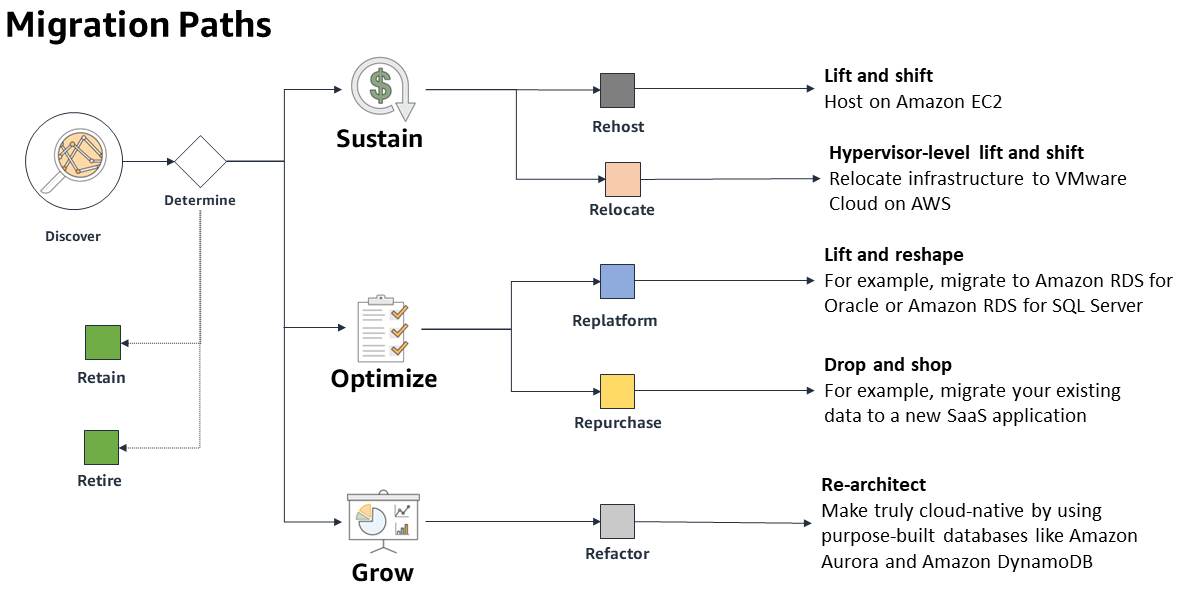How to Understand the 7 Rs Strategies for Moving Applications to the Cloud
Businesses of all sizes are undergoing some form of digital transformation to continue serving their customers and remain relevant, especially in commoditised markets. And “There is no business strategy without a cloud strategy” as observed by Milind Govekar, distinguished vice president at Gartner.
In our always-on era, you will experience customers churn to your digitally agile competition as a result of poor user experiences often caused by legacy technology stacks. The author recalls working with a customer on a strategic change-the-bank programme whose unpublished goal was to prevent churn to digital native challenger banks that were “born in the cloud”.
Inspired by the storytelling of The Phoenix Project, which in turn was inspired by Eli Goldratt’s The Goal, I present the 7 Rs strategies for cloud migrations as enunciated in the Guide for AWS large migrations by AWS.
Background
Sirius Cybernetics Corp. (SCC), once a household name in domestic robots has seen a steady decline in their revenues over the last three years. A new breed of agile startups has entered the market is able to respond quickly to their customers and are constantly pushing out features against their roadmap. SCC’s board understand that they need to pivot quickly to agile platforms in order to serve their customers better and to attract new ones. To this end, the SCC board have embraced cloud computing as part of their overall digital transformation strategy.
SCC have hired a new CIO, Adam Tyrell, a cloud veteran who has overseen large-scale cloud migrations at Fortune 500 companies such as Acme Corp. and Globex. Following his 90-day Plan to a letter, Adam announced SCC’s “Cloud first” strategy and began handing in notice to their six colo providers. SCC have two years to migrate all of their workloads to AWS cloud.
Adam quickly assembled a core team of PMs, Engineers and Enterprise Architects to form SCC’s first Cloud Centre of Excellence (CCoE). Their first responsibility was to produce an accurate inventory of SCC’s workloads including information about cloud migration goals, e.g. agility/cost/speed. Once the inventory was published, SCC began looking at the options around migrating their applications/workloads to the cloud.
Cloud Migration Strategies
In this article, we look at the 7 Rs migration strategies as illustrated below and incorporate research from Gartner and cross-reference these with use cases from Sirius Cybernetics Corp.

Retire
Getting rid of applications during a migration programme is a quick-win for migration teams. There are various reasons for retiring (decommissioning or archiving) applications, including:
- realising that an application offers little, if any, business value. This is especially true where the cost of running/maintaining an application outweighs its value to the business. SCC’s employee directory FindMe is a good example of an application to retire. It was developed by a former intern before the advent of SCC’s Confluence Cloud rollout.
- removing zombie applications or idle applications which experience low utilisation over a significant time period, e.g. between 2 and 20 percent over a period of 90 days with no inbound network connectivity. There are a number of VMs/applications in SCC’s HackWeek sandbox VLAN which have not been decommissioned following their creation.
Stephen Orban mentions that he “…found that as much as 10% (I’ve seen 20%) of an enterprise IT portfolio is no longer useful, and can simply be turned off.” Similarly, SCC have identified 8% of the identified applications as no longer in use company-wide. Some applications such as FinanceWeb duplicate the functionality of application YouFin and were still in use by employees who had not been trained to use YouFin.
Retain
Some applications cannot be migrated outside of a data centre due to physical dependencies on things such as USB licensing dongles. The choice here is to either replace the application or retain as-is. Again, in SCC’s case, time constraints drive the latter. A good use case is SCC’s call centre analytics platform, VoIPAnalyze which uses a USB dongle to validate its licence.
Rehost
Although lift-and-shift (Rehosting) is often associated with data centre exits, it is almost always the option of last resort. You are unable to leverage cloud managed services and gain nothing in terms of agility for your applications. However, there may be compelling reasons to rehost such as in the case of SCC’s in-house Finance application YouFin which was developed by a niche software consultancy who have since dissolved. While decisions around replacing the application are ongoing, the project kick-off is expected to be after the planned data centre exit. This leaves no scope for YouFin to be replaced with e.g. a SaaS offering nor the time to Replatform (AKA lift-tinker-and-shift). However, running a Cloudamize Assessment against servers/VMs hosting applications such as YouFin will provide suggestions around capacity planning in the cloud, e.g. EC2 instance type/sizes thereby offering some optimisation. Interestingly, Gartner’s research shows that only 15% of applications considered were selected to be rehosted to the cloud.
Relocate
Also referred to as a hypervisor-level lift and shift, it is a migration strategy specific to VMC (VMware Cloud on AWS) whereby a VM is migrated intact to AWS cloud. SCC has 4 ESXi clusters containing 120 VMs servicing its core business applications which are earmarked for migration to VMC. Due to time constraints, a rehost was not considered.
Replatform
Also affectionately referred to as “lift-tinker-and-shift”, here you are not fundamentally changing the application architecture nor carrying out a complete refactoring of code. Instead, you are slightly augmenting the application to benefit from some cloud services such as managed databases e.g Amazon RDS. 22% of applications needed to be revised to run on cloud platforms according to the same Gartner report. The migration team have identified 20 applications at SCC whose backends can be switched to RDS MySQL.
Repurchase
Where an application cannot be easily remediated by the other “R” modernisation options, replacing the application with a custom-built application or moving to a SaaS application are the remaining options. The SaaS option is especially prevalent where an organisation has identified a Buy before build strategy. As an example, SCC’s ageing Customer CRM application ContactRM had already been targeted for replacement by a SaaS application, Salesforce. As SaaS applications completely remove the management overhead of an application, it is not surprising that Gartner has reported Replace as a popular choice with 40% opting for this choice.
Rearchitect
Here, much of the application code can be reused but its structure is changed to run better in the cloud or to simply take the opportunity to move from a monolithic architecture to a service-oriented one. It can be argued that the effort required to re-architect an application is better used in rebuilding it. However, rearchitecting may be a short-term tactical move in consideration of resource constraints. Predictably, Gartner identified only 2% of applications as falling into this category. SCC’s HR system People1st has been earmarked for rearchitecting with significant progress already being made with containerising its key components and decoupling the front-end from the business logic.
Conclusion
While fast-growing and agile startups “born in the cloud” may develop applications with a serverless or FaaS-first goal, most enterprises are at the beginning of their cloud journeys and often bring decades of software “baggage” with them. They cannot rearchitect their applications on-the-fly and it may take several years to realise the true agility benefits of the cloud.
It can be argued that enterprises are creating additional technical debt in the cloud by adopting a defacto Rehosting strategy. However, locating workloads in the cloud gives enterprises access to managed cloud services such as RDS, SES and others. Therefore, application architectures can be augmented to take advantage of cloud services through a Replatforming exercise, bringing them one step closer to modernizing their applications.
Once workloads are in the cloud, the evolution of their architecture continues as depicted by Gartner below:

Mohammed Munem is a Principal Consultant at Daemon

